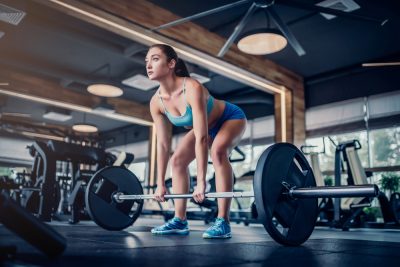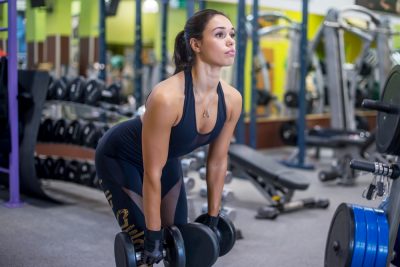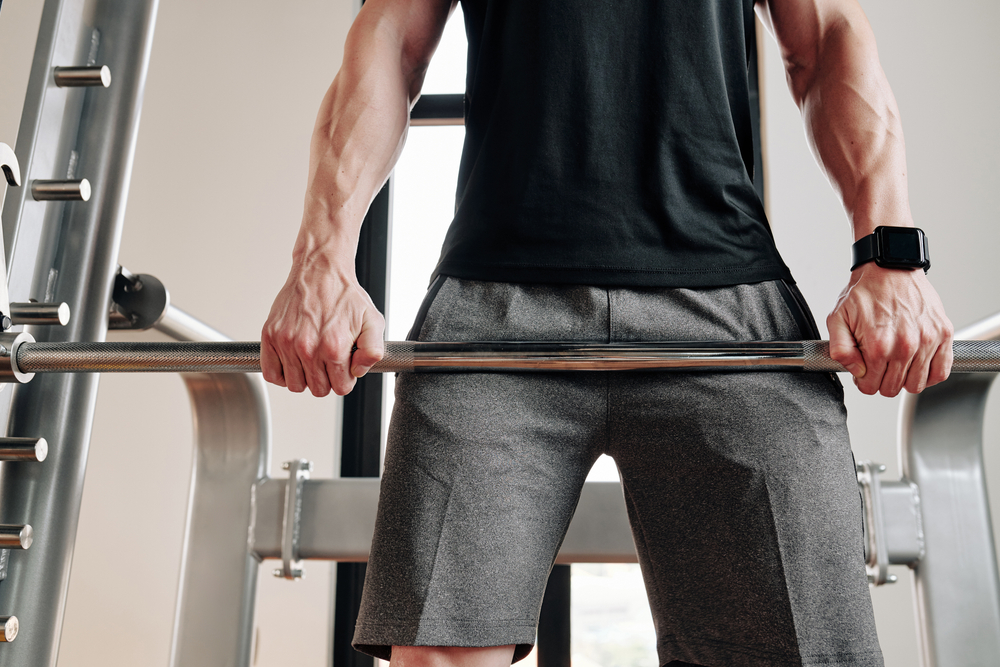Most people classify deadlift as the best exercise for bodybuilders and athletes because it focuses on developing all the muscles located in the legs and back.
But, if deadlift is termed as the best, then stiff leg deadlift should be categorized as the best of the best.
The stiff leg deadlift is just one variation of the deadlift exercise, but what makes it entirely different are the muscles it focuses on. So, it’s fair to say that deadlift exercise is entirely different from stiff leg deadlift,
To effectively perform a stiff leg deadlift, you would need to make use of a barbell, and you can also incorporate lifting straps if you have them at your disposal. You can also make use of chalk if it’s available. However, if you are going to get yourself involved with hefty weights, then it’s best to make use of wrist straps.
Stiff Leg Deadlift Form
When doing the stiff leg deadlift, you should stand over the barbell, and with an overhand grip, make sure that your palms are towards the direction of the ground. Also, make sure your torso isn’t bent at all, and ensure you are standing shoulder-width apart. However, if you are uncomfortable in this position, you can employ a narrower stance, but remember that this isn’t a sumo lift, so keep your knees bent a little.
While you are lifting the barbell, bend your waist and keep your back straight, and raise the barbell above your feet.
Make sure you breathe in while you are bending, and breathe out as you are lifting the weight up. This may seem like a minor feat, but your breathing technique is what determines your overcoming past plateaus.
When doing this exercise, you are expected to feel a pull in your hips and hamstrings; this is a sign that you are in the right form. It also indicates that your lower back is also working, but be careful so it doesn’t do the majority of the work, as this might lead to serious injury. Use your hamstrings and hips to engage the weight, and that way, you can be sure that you are on the right track.
However, if you are recovering from an injury, or you are a bit incapacitated in your movement, then it would be best to put the rack on a rack pull to reduce the strain your body would feel, pending when you fully recover, and your strength is back to the maximum.
Push the lift from your heels instead of toes, as this would help in keeping your stance straight and prevent you from engaging the wrong muscles. So, with this move, the major focus would be on your hips and hamstrings.
Common Mistakes People Make When Doing the Stiff Leg Deadlift
Most people are not attentive, and hence do not even notice when the bar goes away from their body, in their effort to lift the weight. The bar isn’t supposed to drift; instead, it should remain very close to your body, and remember flailing your limbs won’t do you any good.
You have to be in control of your movements at all times; there should be no sudden or hopping movements while doing the stiff leg deadlift.
Keep your moves slow and calculated, and keep your elbows always locked, so it doesn’t flap. Not keeping your elbows locked can even give you the feeling of having the bar shift away from your possession, and that alone can wreck you mentally. So, you can see that it’s not just about lifting the bar into the air; it’s about engaging the right set of muscles.
Note that this exercise has nothing to do with your spine, so if you are feeling pressure on your spine while lifting weights, then you are doing something wrong. Check your form, and make sure you are on the right track, or else you can cause severe damage to yourself. The fact that this exercise involves the muscles in your upper back doesn’t mean your spine should get involved.
Normal Deadlift vs. Stiff Leg Deadlift
Sometimes, people confuse normal deadlift for the stiff leg deadlift; although they have their similarities, they are different.
First, the stiff leg deadlift has an entirely different starting position, and it involves you raising your hips higher and putting your shins in an upright stance. Due to this position, a different set of primary muscles are focused on than in the standard deadlift.
Due to the beginning position and your straight legs, it takes away one set of joints and muscle groups needed to lift the weight off the floor. But with the normal deadlifts, you can advance to using greater weights, and that’s because of your bent knees and plunging movements. For the stiff leg deadlift, your hamstrings and hips are the major focus, but it does involve a bit of the spine and lower back.
Romanian Deadlift vs. Stiff Leg Deadlift
When doing the Romanian deadlift, you are going to be involving the glutes more because your knee has to bend more to make it easier for you to lift heavier weights.
But, the stiff leg deadlift is a better option if the goal is to increase your deadlift strength because you need to lower the bar very close to the floor, and this would boost your above-the-floor lifting power.
Benefits of Doing the Stiff Leg Deadlifts Exercise

You can call the stiff leg deadlift an isolating exercise because it focuses on muscular hypertrophy, meaning that you can get exceptional results by doing some intense actions.
One of the best effects of the stiff leg deadlift is its impact on the posterior chain because that’s what determines your posture and strength. The stiff leg deadlift helps to strengthen your lower back and also gives fuel to your jumping and running capabilities. Think of this exercise as a method of improving your overall strength.
Stiff leg deadlifts also work on your hip extension and flexion, and this is vital in your everyday movement, ranging from standing up to jerking and even squatting.
It’s a known fact that all lifts, when done from a standing position, isn’t in compliance with gravity, so the stiff leg deadlift helps to improve your bone density. You would appreciate this benefit more as you begin to age and your bone density gradually declines.
The Muscles Worked When Doing the Stiff Leg Deadlift
The primary targeted muscle in the stiff leg deadlift is the hamstring, and because being stable is important; your core has to be involved as well. Other muscles include:
- Gluteus Maximus
- Erectors
- Lats
Recommended Training Gears For Stiff Leg Deadlifts
- Lifting Belts
- Foam Rollers
- Lifting Straps
Variations of the Stiff Leg Deadlift Exercise
- Stiff-Legged Barbell Deadlift
This is a more complex and rounded form of a stiff leg deadlift and would give you more results than the standard deadlift. The stiff-legged barbell deadlift focuses on the lower and upper back, the hamstrings, glutes, and also the core. It indirectly works on the forearms, calves, and quads.
While doing this variation, it would be a bit easier to add more weights, and you would get to place more concentration on the lift rather than your arms flapping like it would when you are dealing with dumbbells.
However, if you feel that your grip is somewhat limited when doing this exercise, then you can make use of lifting straps.
- Stiff Single Leg Deadlift
This is most common among runners and sports lovers because it personally works on your legs as though you are running. You can decide to make use of two dumbbells or one; alternatively, you can even use a barbell, anyone which works best for you. However, you have to remember to keep the weight light, so you don’t alter your form and put yourself at risk of getting injured.
Begin this variation by placing your legs in the standard stiff leg deadlift position, by putting your weight in front of your legs. While bending forward, lift one of your legs off the floor from behind, and lower the weight. Ensure that your raised leg isn’t bent at all, and the moment you begin to feel a pull in the hamstring of the grounded leg, then return the weight up and put down your raised leg.

- Dumbbell Stiff Leg Deadlift
Personal trainers usually recommend this type of variation because it allows you the freedom of a free range of motion, although it shouldn’t be done all the time. When doing the dumbbell stiff leg deadlift variation, you can modify your angle if you don’t feel entirely comfortable, and importantly, your balance. If you aren’t in the best shape, or your limb does more work than the other, then it can lead to unevenness. But making use of dumbbells would help improve your motion and equal out any unevenness in the muscles on both sides of your body.
With this variation, you need to ensure your arms are tighter, so it can engage your abs and lats better. This means you might need to bend more to raise the lift, so your flexion is worked on, and extra muscle fibers are involved.



